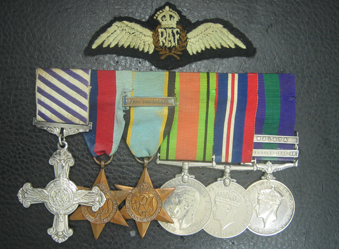
DISTINGUISHED FLYING CROSS, G.VI.R., REVERSE OFFICIALLY DATED ‘1944’; 1939-45 STAR; AIR CREW EUROPE STAR, 1 CLASP, FRANCE AND GERMANY; DEFENCE AND WAR MEDALS 1939-45; GENERAL SERVICE 1918-62, 2 CLASPS, PALESTINE 1945-48, MALAYA ‘SQN. LDR. W. J. BODDINGTON. D.F.C. R.A.F.’ 2ND CLASP LOOSE ON RIBAND, AS ISSUED, WITH R.A.F. CLOTH WINGS, MOUNTED AS WORN.
D.F.C. London Gazette 29 December 1944. The original recommendation states:
‘F/Lt. Bodington [sic] has completed a total of 68 operations - 15 on Mustangs and 53 on Mosquitoes. While on Mustangs he carried out escorts and shipping reconnaissance duties, being credited with one F.W. 190 confirmed destroyed following a raid on Folkestone in 1943. F/Lt. Bodington has carried out 38 night and 15 daylight sorties on Mosquitoes in No. 2 Group. The daylight sorties included Ranger Operations and attacks on Flying Bomb sites.
Attacks against enemy aerodromes, and a large number of sorties in support of the Army in search of enemy transport, were carried out by night. F/Lt. Bodington has shown the greatest perseverance and determination on Operations over a period of 18 months and has added greatly to their success.
Remarks by Air Officer Commanding:
This Officer has done outstanding work over a long period. Many of his operations have been carried out in the face of heavy opposition under very bad weather conditions at night and he well deserves recognition. I very strongly recommend him for the award of the D.F.C.”
William James Boddington was born in Birmingham in March 1921. He was the son of P. J. Boddington, a Surgeon who saw service in the Second Boer War and also served as a Surgeon Captain with the Royal Horse Guards during the Great War. Boddington was educated at Haileybury and R.M.C. Sandhurst, prior to being commissioned Second Lieutenant in the Cameronians in December 1939. He served with the 7th Battalion in France, prior to joining the Headquarters Staff, 156 Brigade. Boddington escaped the fall of France, and advanced to Lieutenant in July 1941. He was seconded to the Royal Air Force in October 1941 and carried out training as a pilot.
https://en.wikipedia.org/wiki/156th_(Scottish_Rifles)_Brigade
Boddington’s pilot training was eventful, especially whilst on Mustangs 15 December 1942. On the latter date he was flying in a formation exercise over the Yorkshire Moors, when he became lost in thick fog. Running low on fuel Boddington attempted to land on Fountains Earth Moor, Nidderdale. The terrain made this impossible, and he was forced to climb to a safe height and bale out:
https://www.yorkshire-aircraft.co.uk/aircraft/planes/dales/ag586.html
Despite the loss of the aircraft, Boddington was still posted for operational flying with ‘A’ Flight, 613 (City of Manchester) Squadron at Ringway in 1943. The Squadron flew Mustangs and were tasked with tactical reconnaissance and flying escort for Coastal Command anti-submarine strikes. According to his D.F.C. recommendation, Boddington was credited with one F.W. 190 destroyed (Combat report suggests damaged), when his formation of Mustangs intercepted an enemy force over Yarmouth following a raid on Folkestone, 11 May 1943.
Boddington advanced to Flight Lieutenant in October 1943, and was with the Squadron when it transferred to No. 2 Group as a light-bomber squadron flying Mosquitoes under the command of Robert ‘Pinpoint’ Bateson.
Throughout the remainder of 1943, and into 1944, Boddington flew on the Squadron’s precision daylight attacks at low-level. His aircraft was damaged by flak whilst carrying out an attack on a Noball target close to Maintenay, 31 December 1943. Targets included V1 launch sites in Northern France, and flak positions and other such targets in the lead-up to D-Day. During one lone Day-Ranger sortie on 16 May 1944, Boddington was tasked with attacking flak positions in the Chateaudun-Orleans area, doing considerable damage and knocking out 3 flak emplacements with his cannons and MG’s. During and post D-Day, Boddington flew a large number of sorties over Normandy, many in support of ground forces, the object to harass, hamper and attack all enemy transport both road and rail.
Flying his last sortie with 613 Squadron on 14 August 1944, Boddington advanced to Squadron Leader, prior to returning to service with the Cameronians after the war:
‘After the war he returned to the Regiment and served with the 1st Battalion in Gibraltar and Triesle.... He served at the Depot in Winston Barracks, Lanark between 1949 and 1951 and thereafter as a GSO 3 at GHQ Farelf. He rejoined the Regiment in Germany in 1955 and went with them to Bahrein in 1957 and thence to Kenya... He retired [Major] in 1958 and after a period with Charrington’s Brewery in London, went to live in Somerset [Manor Farm, Beercrocombe]...’ (Obituary refers)
Major Boddington died in Somerset in 1985.
The Royal Air Force Museum holds in its collections, Boddington’s logbooks 1941-46 and documents:
https://collections.rafmuseum.org.uk/collection/inventory/?q2=bodington
Condition VF, some contact marks. Sold with a good, detailed file of copied research, which includes DFM recommendation, operational logs detailing Boddington’s sorties with 613 Squadron, Gazettes, combat report, newspaper articles etc.
A very fine D.F.C. group to a Mustang and Mosquito fighter pilot who saw a great deal of action during the war, made more interesting by the fact that he served as both an Infantry Officer and R.A.F. pilot